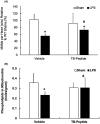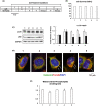Beclin-1 improves mitochondria-associated membranes in the heart during endotoxemia
- PMID: 33733054
- PMCID: PMC7944875
- DOI: 10.1096/fba.2020-00039
Beclin-1 improves mitochondria-associated membranes in the heart during endotoxemia
Abstract
Mitochondria-associated membranes (MAMs) are essential to mitochondria. This study was to determine whether endotoxemia rearranges MAMs in the heart, and whether Beclin-1 regulates this process. Wild-type mice and mice with a cardiac-specific overexpression of Beclin-1 (Becn1-Tg), or a heterozygous knockout of Beclin-1 (Becn1 +/-) were given lipopolysaccharide (LPS) challenge. In the heart, the ultrastructure of MAMs was examined by electron microscopy and the histology evaluated by immunostaining. Additionally, MAMs were isolated by ultracentrifugation, and their content and function were quantified. The effects of Beclin-1-activating peptide (TB-peptide) on MAMs were also examined. Data showed that endotoxemia decreased both the total mass and the function of MAMs, and these deficiencies became worse in Becn1 +/- mice but were alleviated in Becn1-Tg and TB-peptide-treated mice. Responses of myocardial MAMs to LPS and to TB-peptide were additionally examined in AC16 human cardiomyocytes. In vitro findings recaptured the effects of LPS and TB-peptide in cardiomyocytes; the challenge of LPS reduced the level and activity of MAMs, and TB-peptide attenuated this defect. Together, the results suggest a new function of Beclin-1 in improving cardiac MAMs during endotoxemia, providing a mechanism for the previously identified role of Beclin-1 in protection of mitochondria and cardiac function.
Keywords: LPS; MAMs; beclin‐1; cardiac dysfunction; sepsis.
©2020 The Authors. FASEB BioAdvances published by The Federation of American Societies for Experimental Biology.
Figures





Similar articles
-
Evaluation of Parkin in the Regulation of Myocardial Mitochondria-Associated Membranes and Cardiomyopathy During Endotoxemia.Front Cell Dev Biol. 2022 Feb 21;10:796061. doi: 10.3389/fcell.2022.796061. eCollection 2022. Front Cell Dev Biol. 2022. PMID: 35265609 Free PMC article.
-
Age-Independent Cardiac Protection by Pharmacological Activation of Beclin-1 During Endotoxemia and Its Association With Energy Metabolic Reprograming in Myocardium-A Targeted Metabolomics Study.J Am Heart Assoc. 2022 Jul 19;11(14):e025310. doi: 10.1161/JAHA.122.025310. Epub 2022 Jul 5. J Am Heart Assoc. 2022. PMID: 35861821 Free PMC article.
-
Hyperglycemia-Driven Inhibition of AMP-Activated Protein Kinase α2 Induces Diabetic Cardiomyopathy by Promoting Mitochondria-Associated Endoplasmic Reticulum Membranes In Vivo.Circulation. 2019 Apr 16;139(16):1913-1936. doi: 10.1161/CIRCULATIONAHA.118.033552. Circulation. 2019. PMID: 30646747 Free PMC article.
-
Mitochondria-associated membranes (MAMs) and inflammation.Cell Death Dis. 2018 Feb 28;9(3):329. doi: 10.1038/s41419-017-0027-2. Cell Death Dis. 2018. PMID: 29491386 Free PMC article. Review.
-
Mitochondria-Associated ER Membranes - The Origin Site of Autophagy.Front Cell Dev Biol. 2020 Jul 16;8:595. doi: 10.3389/fcell.2020.00595. eCollection 2020. Front Cell Dev Biol. 2020. PMID: 32766245 Free PMC article. Review.
Cited by
-
Restoring the infected powerhouse: Mitochondrial quality control in sepsis.Redox Biol. 2023 Dec;68:102968. doi: 10.1016/j.redox.2023.102968. Epub 2023 Nov 23. Redox Biol. 2023. PMID: 38039825 Free PMC article. Review.
-
IL-6/STAT3 Signaling Promotes Cardiac Dysfunction by Upregulating FUNDC1-Dependent Mitochondria-Associated Endoplasmic Reticulum Membranes Formation in Sepsis Mice.Front Cardiovasc Med. 2022 Jan 18;8:790612. doi: 10.3389/fcvm.2021.790612. eCollection 2021. Front Cardiovasc Med. 2022. PMID: 35118141 Free PMC article.
-
Deciphering functional roles and interplay between Beclin1 and Beclin2 in autophagosome formation and mitophagy.Sci Signal. 2023 Jan 31;16(770):eabo4457. doi: 10.1126/scisignal.abo4457. Epub 2023 Jan 31. Sci Signal. 2023. PMID: 36719945 Free PMC article.
-
Evaluation of Parkin in the Regulation of Myocardial Mitochondria-Associated Membranes and Cardiomyopathy During Endotoxemia.Front Cell Dev Biol. 2022 Feb 21;10:796061. doi: 10.3389/fcell.2022.796061. eCollection 2022. Front Cell Dev Biol. 2022. PMID: 35265609 Free PMC article.
-
An Update on the Study of the Molecular Mechanisms Involved in Autophagy during Bacterial Pathogenesis.Biomedicines. 2024 Aug 5;12(8):1757. doi: 10.3390/biomedicines12081757. Biomedicines. 2024. PMID: 39200221 Free PMC article. Review.
References
-
- Levy MM, Dellinger RP, Townsend SR, et al. The Surviving Sepsis Campaign: results of an international guideline‐based performance improvement program targeting severe sepsis*. Critical Care Med. 2010;38(2):367–374. - PubMed
-
- Walley KR. Sepsis‐induced myocardial dysfunction. Curr Opin Crit Care. 2018;24:292–299. - PubMed
-
- Zanotti‐Cavazzoni SL, Hollenberg SM. Cardiac dysfunction in severe sepsis and septic shock. Curr Opin Crit Care. 2009;15:392–397. - PubMed
Grants and funding
LinkOut - more resources
Full Text Sources
Other Literature Sources
Miscellaneous
